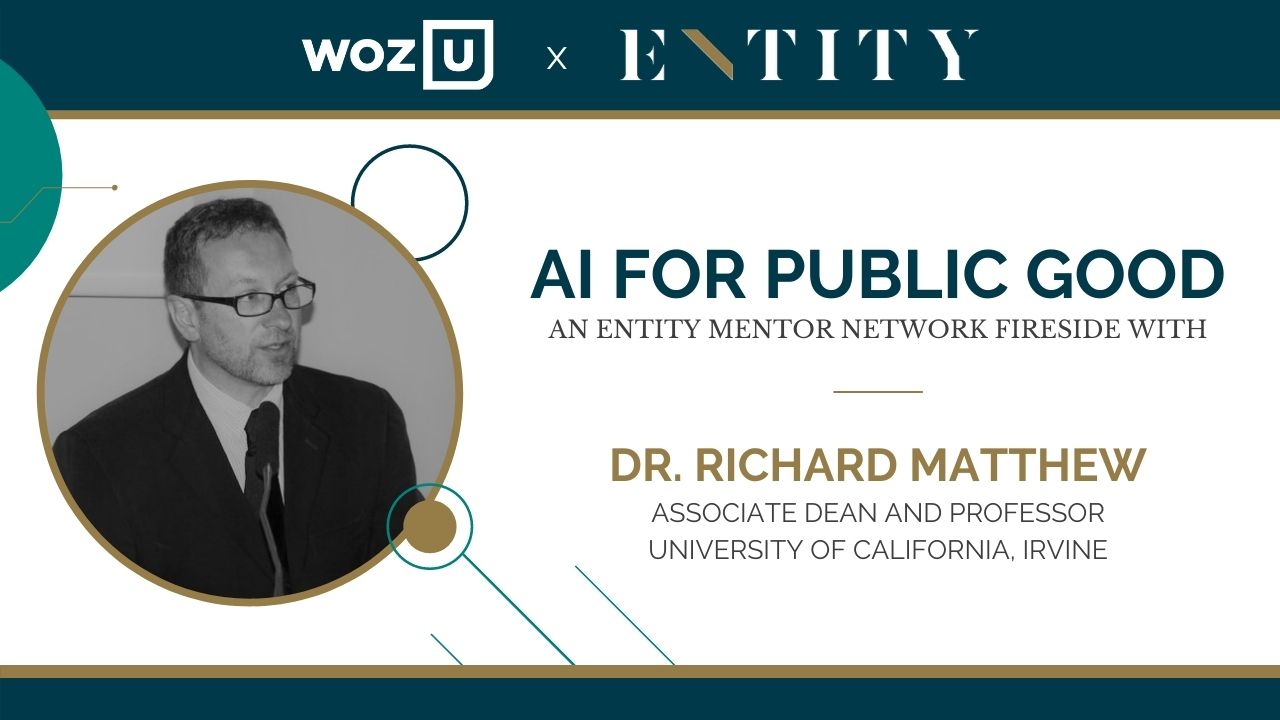Artificial Intelligence has gone from something out of science fiction to something we use nearly every day. Many large corporations use data and other sources of information to teach machines how to act and how to perform certain tasks. While this may seem scary at first glance, AI and Big Data can actually be a force for public good for different societies and our environment.
At a Fireside Chat hosted by WOZ U and ENTITY Academy, Dr. Richard Matthew spoke to aspiring data scientists and machine learning engineers about this very topic.
Richard Matthew is a man of many titles. He is a Professor of Urban Planning and Public Policy, Associate Dean for Research and International Programs, and Director of the Blum Center for Poverty Alleviation at the University of California Irvine. He is also a Senior Fellow at IISD in Geneva; a member of the United Nations Expert Group on Environment, Conflict, and Peacebuilding; a member of the IUCN Commission on Environmental, Economic and Social Policy and co-chair of its Task Force on Conservation, Migration, and Conflict; and the Vice-President of the Environmental Peacebuilding Association. Additionally, he is PI of an NSF EAGER project and Co-PI of the FloodRISE and SedRise projects.
Dr. Matthew’s research explores the intersections of environmental issues, global poverty, and public health and how all these things influence each other. He is also exploring if science and technology can be used to help intervene in these crises. Here are three ways Dr. Matthew cited that AI and Data Science can be used for public and social good.
1. Disaster Preparation
Dr. Matthew is one of the hundreds of researchers from around the world that are collecting and analyzing data on environmental events, from tropical storms to droughts and everything in between. Right now, unsurprisingly, the world is past critical thresholds and the future of our environment, “looks bleak.”
Dr. Matthew talked about how some of the earliest humanitarian missions in his career with the United Nations brought him to places like Pakistan, Rwanda, Sierra Leone, and more, where he and his team researched how floods were damaging “traditional” civilizations.
These floods would destroy entire communities and entire farms of crops would be wiped out.
In Rwanda for example, he and his team worked with local communities to collect environmental data about flooding. They found that climate change was leading to changes in water levels, and increased soil erosion, leaving communities without natural protection from the rising waters when it rained.
With the data they collected, they were able to look at the erosion from past floods and make predictions about the amount of destruction that could occur in the next couple of years. Knowing what is likely to happen in the future can help communities be ready for the next rainy season.
More recently, the Blum Center for Poverty Alleviation’s FloodRISE project has used Artificial Intelligence to create topographical models of different areas by using data collected using Google Street View and knowledge from local communities. With these models, they can accurately see where water naturally pools, how quickly it can flow to certain areas, and what areas will probably take the most damage.
Using these models, they can answer questions such as, “How much time would I have to evacuate my home?” or, “Where would I be able to go to escape the flooding?”
Even more importantly, they can use these models to simulate possible solutions to flooding. How can we improve drainage? Do we need more sea walls or sand dunes? Where should we place them?
Dr. Matthew explains that these types of simulations used to take multiple supercomputers to run. But today, “It can be done on your desktop with just a push of a button.”
2. Health Crises
Dr. Matthew explained that health crises around the world are directly related to changes in the environment.
One of the projects he has worked on was improving WASH systems (Water, Sanitation, and Hygiene) in Bangladesh. The major health crisis people were running into in rural areas was waterborne illness. In fact, Dr. Matthew cited this as the leading cause of death in Bangladeshi refugee camps.
The problem is that chlorine needs to be added to the drinking water to keep disease-carrying pathogens from populating. Too much chlorine renders the water undrinkable and too little chlorine can help the pathogens recover faster.
His team collected data to build AI models to simulate amounts of chlorine in the water, the level of pathogens, the time that people collect the water to bring home, and how long it takes them to drink all of the water they collected on that day. Once they ran these simulations, they were able to predict how long it would take for the water to become undrinkable after collection, leading to a massive improvement in that community’s health and wellness.
3. Gun Violence
Dr. Matthew explained that when a police officer or someone who is trying to stop a home invader is face to face with a potentially deadly situation, there is little to no time to properly assess the level of danger they are facing.
With the help of computers and AI, we may be able to cut down on human error and have fewer accidental deaths. Machines can make quicker, split-second decisions than the human brain.
According to the Gun Violence Archive, as of March 20, 2021, there has been 9,196 gun deaths total in the United States since Jan. 1, 2021, but homicides did not make up the majority of these deaths. Of these deaths, 5,124 were suicides. Looking at past years, this is something that remains consistent – every year half, sometimes more than half, of these deaths are intentional and self-inflicted.
Dr. Matthew explained that according to data collected about suicide, when most people decide to kill themselves, they typically do so within half an hour of making that decision. But, if there is some sort of intervention, they will more often than not decide not to commit suicide. However, when using a gun, there is often not much time for anyone to intervene. If there was a way to introduce interventions quicker or render guns inoperable in time, these deaths could be prevented.
However, the United States has a long way to go before we can make active change in gun violence. For about 20 years, the U.S. government cut off funding to any gun violence research projects that could “promote” gun control. It was only in 2019 that U.S. lawmakers agreed to fund CDC research projects about gun violence. This means two decades of gun violence data have been lost to the annals of history, and researchers will need to start from scratch.
Final Thoughts on AI for Public Good
Dr. Matthew’s talk highlighted many ways that data-fueled AI simulations can potentially help combat various global crises.
However, he does acknowledge a lot of the concern surrounding the use of AI Machines that cannot capture emotions like compassion or creativity. While sticking to numbers and statistics appears to make research more objective, there will always be outliers that need to be examined with a critical, human lens.
But for now, Artificial Intelligence models can certainly help fill knowledge gaps and start to make the world a better place.
If you’re interested in a job in data science, WOZ U training is available to you at home or anywhere with an internet connection from many of our higher education partners. Learn more about our powered by WOZ Data Science program.

Maria Rotelli
Maria Rotelli is the Editorial and Content lead at ENTITY Academy, an EdTech company that is on a mission to close the gender pay gap by providing women with in-demand hard skills, soft skills, and leadership training, as well as mentorship.
Maria holds a B.A. in Psychology from Clark University and an M.A. in Journalism from Emerson College. She is based out of Los Angeles, California.




